| Home |
| Acknowledgments |
| Conventions |
| Glossary |
| Maps |
| References |
| Links |
| Articles |
| Thumbnails |
| Species
list |
| Family |
| Next
species |
Additional Photos

underside

side

light
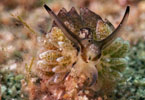
dark central cerata

notum pigment
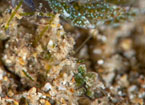
young

pair

groups, in field
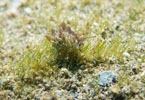
feeding
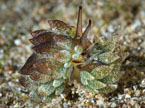
mating
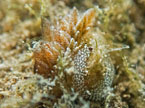
with egg mass

Costasiella formicaria (Baba, 1959)
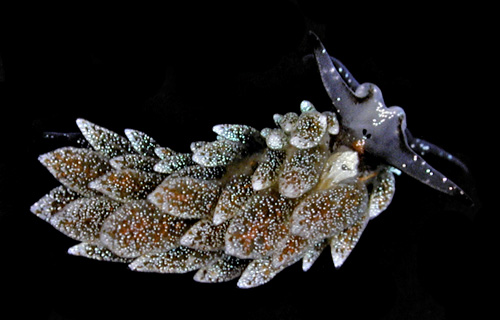
| Maximum size: about 15 mm. Identification: This animal has a cream body frosted with dusky gray and flecked with white. The gray pigment is densest on the edges of the rhinophores and head but varies in intensity and distribution. The cardiac sack is dark. The branches of the digestive gland in the cerata range from olive green to golden brown, again with variation in intensity. It may become darker with age and the central cerata may be markedly darker than the lateral cerata. Natural history: Prior to 2020, Costasiella formicaria was known from only three animals found in highly protected to moderately exposed locations. The one Maui animal came from a moderately exposed rocky area at 3-7 m (10-28 ft). In 2020 and 2021, many animals were found at depths of 6-12 m (19-40 ft) on open sand and in Halimeda kanaloana beds where it appears to feed on a sand-dwelling, filamentous green alga. Japanese animals fed on a similar-appearing algae identified as Pseudochlorodesmis furcellata (Jensen, et. al., 2014). It lays a white, collar-shaped egg mass and its cerata are readily autotomized. During population blooms they may form mating, resting and/or migratory aggregations. (Note 1) Distribution: Big Island, Maui, Oahu and Midway: also known from Japan. Taxonomic notes: It was first recorded in Hawaii from Kaneohe Bay, Oahu by Terry Gosliner. Photo: PF: Midway Atoll; May 30, 1993. Observations and comments: Note 1: Kelly McCaffrey (and others) reported seeing 50 to 100 animals on multiple occasions on open sand and on sand between Halimeda kanaloana patches (crawling, by day). He reported sizes ranging from 7-8 mm to about 15 mm with larger animals being darker. Animals were often seen in moderately large groups suggesting that they form mating aggregations and/or migrate between patches of algae as local food is exhausted. For a video of an aggregation (by Kelly Mccaffrey) click here. Pam Madden also found dense clumps of resting animals at night suggesting that they may stay together for prolonged periods. (see photos) |
| Thumbnails |
Species
list |
Family | Next species | Top |